Large Eddy Simulation of Near-Bed Flow and Turbulence over Roughness Elements in the Shallow Open-Channel
Abstract
:1. Introduction
2. Methods
2.1. The Continuity and Navier–Stokes Equations
2.2. Subgrid-Scale Turbulence Model
2.3. Geometry Description
2.4. Boundary Conditions
- Cyclic condition was applied in the -direction between the inlet and outlet.
- Similarly, cyclic condition was applied in the -direction between the two lateral boundaries.
- The water surface was approximated as a rigid lid, on which the shear stresses in the - and -direction were zero and the normal velocity was zero (or ).
- The channel-bed was a no-slip wall, at which all velocity components were zero (or ).
2.5. Grid Configuration
3. Results
3.1. Mean Flow Velocity
- For the d-type of roughness, vertical profiles of the mean-flow velocity in the streamwise direction had shapes resembling those in the classic turbulent boundary layer over a flat plate. However, the presence of roughness elements caused the profiles to shift in a vertical position to a certain extent, depending on the proximity to a roughness element.
- For the k-type of roughness, vertical profiles of the mean-flow velocity in the streamwise direction exhibited changing patterns in the vicinity of roughness elements.
- For both types of roughness, exchange of fluid mass between the cavity and outer region occurred near the roughness height plane, as can be seen from the positive and negative values for the mean-flow velocity in the vertical direction.
- Vertical motion in the middle water column is seen from the experimental data. LES with the rigid lid approximation encountered difficulties in capturing such motion.
3.2. Turbulence Intensity
3.3. Reynolds Shear Stress
3.4. Flow Characteristics at Intermediate Ratios
4. Discussion
- One similarity was that the flows were all complicated in the cavity, where multiple eddies were present, with different sizes and rotation directions, depending on the spacing of roughness elements.
- Another similarity was that the flows all showed a large clockwise vortex and a small anticlockwise vortex on the left in the cavity. The vertical dimension of the large vortex was limited by the roughness height. The vertical dimension of the small vortex was limited to one half the roughness height.
- One difference was the elongation of the larger vortex. Its aspect ratio (the height in the -direction to the width in the -direction) appeared to be limited to 1 to 3 (or 1 vertical-to-3 horizontal).
- Another difference was the generation of a vortex on the right.
5. Conclusions
Author Contributions
Funding
Conflicts of Interest
Abbreviations
| LES | Large eddy simulation |
References
- Townsend, A.A. The Structure of Turbulent Shear Flow, 2nd ed.; Cambridge University Press: Cambridge, UK, 1980; p. 429. [Google Scholar]
- Henderson, F.M. Open Channel Flow; Prentice Hall: Upper Saddle River, NJ, USA, 1966; p. 522. [Google Scholar]
- Cantwell, B.J. Organized motion in turbulent flow. Ann. Rev. Fluid Mech. 1981, 13, 457–515. [Google Scholar] [CrossRef]
- Panton, R.L. Overview of the self-sustaining mechanisms of wall turbulence. Prog. Aerosp. Sci. 2001, 37, 341–383. [Google Scholar]
- Robinson, S.K. Coherent motions in the turbulent boundary layer. Ann. Rev. Fluid Mech. 1991, 23, 601–639. [Google Scholar] [CrossRef]
- Hinze, J. Turbulence: An Introduction to Its Mechanism and Theory; McGraw-Hill: New York, NY, USA, 1959; p. 586. [Google Scholar]
- Tennekes, H.; Lumley, J.L. A First, Course in Turbulence; MIT Press: Cambridge, MA, USA, 1972; p. 320. [Google Scholar]
- Wilcox, D.C. Turbulence Modeling for CFD, 3rd ed.; DCW Industries: La Canada, CA, USA, 2006; p. 522. [Google Scholar]
- Rau, G.; Akan, M.C.; Moeller, D.; Arts, T. The effect of periodic ribs on the local aerodynamic and heat transfer performance of a straight cooling channel. J. Turbomach. 1998, 120, 368–375. [Google Scholar]
- Perry, A.E.; Schofield, W.H.; Joubert, P.N. Rough wall turbulent boundary layers. J. Fluid Mech. 1969, 37, 383–413. [Google Scholar] [CrossRef]
- Chow, V.T. Open-Channel Hydraulics; MCGraw Hill: Caldwell, NJ, USA, 1959; p. 680. [Google Scholar]
- Bagherimiyab, F.; Lemmin, U. Shear velocity estimates in rough-bed open-channel flow. Earth Surf. Process. Landf. 2013, 38, 1714–1724. [Google Scholar] [CrossRef] [Green Version]
- Tachie, M.; Adane, K. PIV study of shallow open channel flow over d-and k-type transverse ribs. J. Fluids Eng. 2007, 2007 129, 1058–1072. [Google Scholar] [CrossRef]
- Djenidi, L.; Elavarasan, R.; Antonia, R.A. The turbulent boundary layer over transerve square cavities. J. Fluid Mech. 1999, 395, 271–294. [Google Scholar]
- Volino, R.J.; Schultz, M.P.; Flack, K.A. Turbulence structure in boundary layers over periodic two-and three-dimensional roughness. J. Fluid Mech. 2011, 676, 172. [Google Scholar] [CrossRef] [Green Version]
- Okamoto, S.; Seo, S.; Nakaso, K.; Kawai, I. Turbulent shear flow and heat transfer over the repeated two-dimensional square ribs on ground plane. J. Fluid Eng. 1993, 115, 631–637. [Google Scholar] [CrossRef]
- Deardorff, J.W. A numerical study of three-dimensional turbulent channel flow at large Reynolds numbers. J. Fluid Mech. 1970, 41, 453–480. [Google Scholar] [CrossRef]
- Smagorinsky, J. General circulation experiments with the primitive equations: I. The basic experiment. Mon. Weather Rev. 1963, 91, 99–164. [Google Scholar] [CrossRef]
- Coceal, O.; Dobre, A.; Thomas, T.G.; Belcher, S.E. Structure of turbulent flow over regular arrays of cubical roughness. J. Fluid Mech. 2007, 589, 375–409. [Google Scholar] [CrossRef] [Green Version]
- Leonardi, S.; Orlandi, P.; Antonia, R.A. Properties of d-and k-type roughness in a turbulent channel flow. Phys. Fluids 2007, 19, 125101. [Google Scholar] [CrossRef]
- Miyake, Y.; Tsujimoto, K.; Agata, Y. A DNS of a turbulent flow in a rough-wall channel using roughness elements model. JSME Int. J. Ser. B Fluids Therm. Eng. 2000, 43, 233–242. [Google Scholar] [CrossRef] [Green Version]
- Ansys, Inc. ANSYS Fluent Theory Guide 15.0.; Ansys, Inc.: Canonsburg, PA, USA, 2013. [Google Scholar]
- Ducros, F.; Nicoud, F.; Poinsot, T. Wall-adapting local eddy-viscosity models for simulations in complex geometries. In Numerical Methods for Fluid Dynamics VI; Oxford University Computing Laboratory: Oxford, UK, 1998; pp. 293–299. [Google Scholar]
- Dritselis, C.D. Large eddy simulation of turbulent channel flow with transverse roughness elements on one wall. Int. J. Heat Fluid Flow 2014, 50, 225–239. [Google Scholar] [CrossRef]
- Germano, M.; Piomelli, U.; Moin, P.; Cabot, W.H. A dynamic subgrid-scale eddy viscosity model. Phys. Fluids A Fluid Dyn. 1991, 3, 1760–1765. [Google Scholar] [CrossRef] [Green Version]
- Meneveau, C.; Lund, T.S.; Cabot, W.H. A Lagrangian dynamic subgrid-scale model of turbulence. J. Fluid Mech. 1996, 1996 319, 353–385. [Google Scholar] [CrossRef] [Green Version]
- Kobayashi, H. Large eddy simulation of magnetohydrodynamic turbulent channel flows with local subgrid-scale model based on coherent structures. Phys. Fluids 2006, 18, 045107. [Google Scholar] [CrossRef]
- Choi, H.; Moin, P. Grid-point requirements for large eddy simulation: Chapman’s estimates revisited. Phys. Fluids 2012, 24, 011702. [Google Scholar] [CrossRef]
- Gerasimov, A. Quick Guide to Setting Up LES-Type Simulations; ANSYS Sweden AB: Goteborg, Sweden, 2016. [Google Scholar]
- Dryden, H.L.; Kuethe, A.M. Effect of Turbulence in Wind Tunnel Measurements; Technical Reports No. 342; National Advisory Committee for Aeronautics: Washington, DC, USA, 1930.
- Cui, J.; Patel, V.C.; Lin, C.L. Large-eddy simulation of turbulent flow in a channel with rib roughness. Int. J. Heat Fluid Flow 2003, 24, 372–388. [Google Scholar] [CrossRef]
- Iacono, G.L.; Tucker, P.G.; Reynolds, A.M. Predictions for particle deposition from LES of ribbed channel flow. Int. J. Heat Fluid Flow 2005, 26, 558–568. [Google Scholar] [CrossRef]
- Kline, S.J.; Morkovin, M.V.; Sovran, G.; Cockrell, D.J. Computation of Turbulent Boundary Layers—1968 AFOSR-IFP-Stanford Conference Proceedings; Thermsciences Division, Standford University: Standford, CA, USA, 1969. [Google Scholar]
- Vijiapurapu, S.; Cui, J. Simulation of turbulent flow in a ribbed pipe using large eddy simulation. Numer. Heat Transf. Part A Appl. 2007, 51, 1137–1165. [Google Scholar] [CrossRef]
- Xie, Z.; Lin, B.; Falconer, R.A. Turbulence characteristics in free-surface flow over two-dimensional dunes. J. Hydro-Environ. Res. 2014, 8, 200–209. [Google Scholar] [CrossRef]
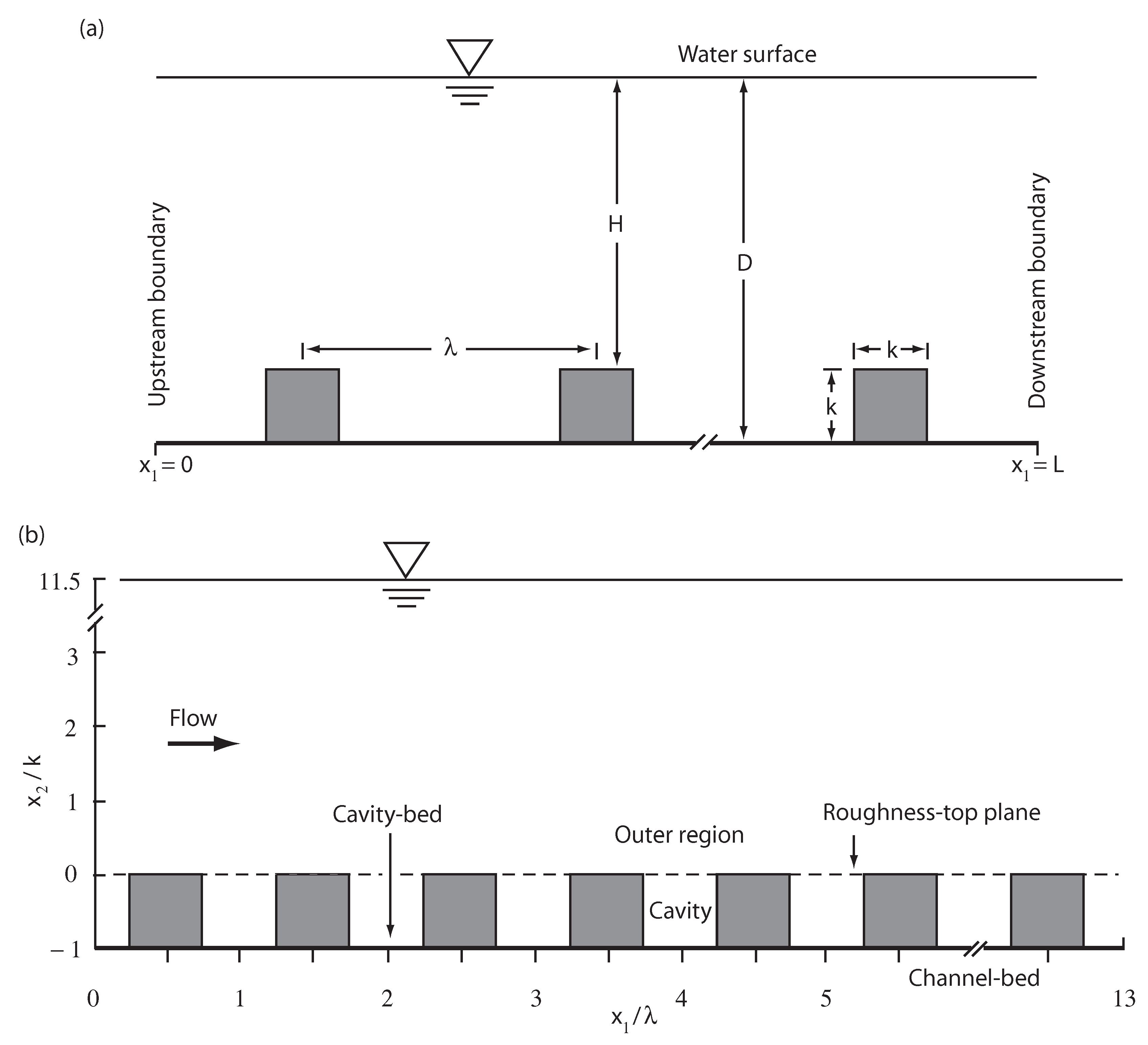
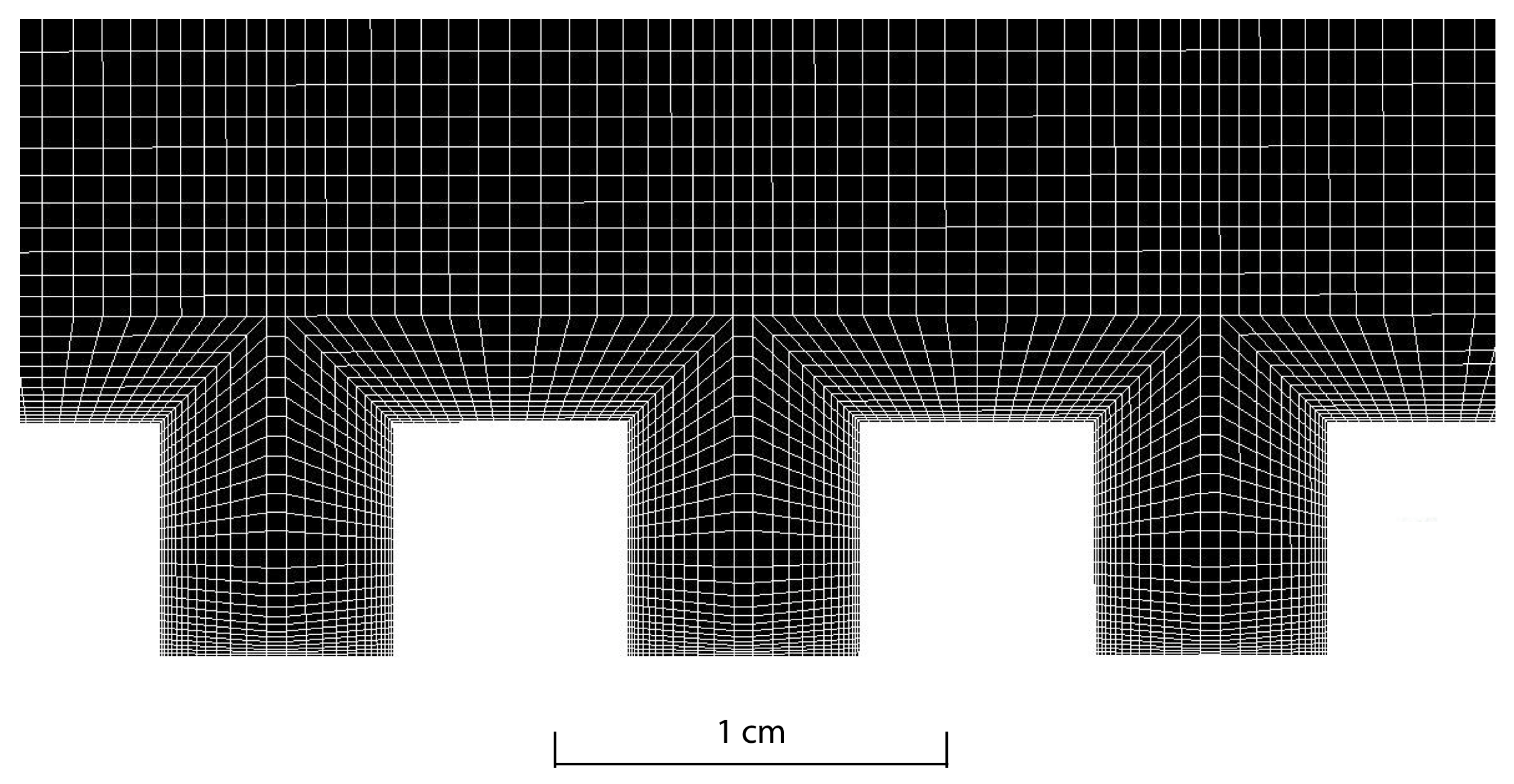
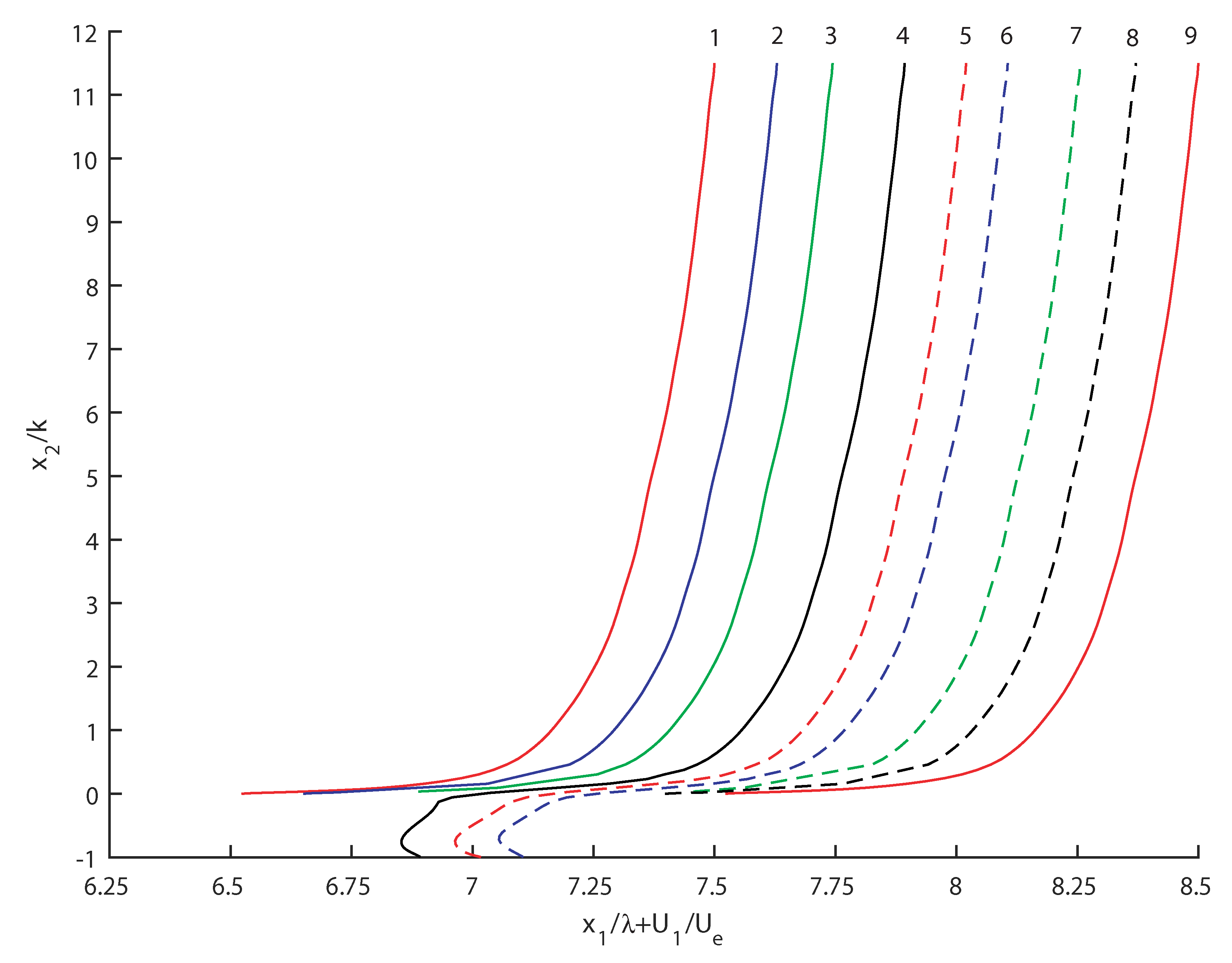
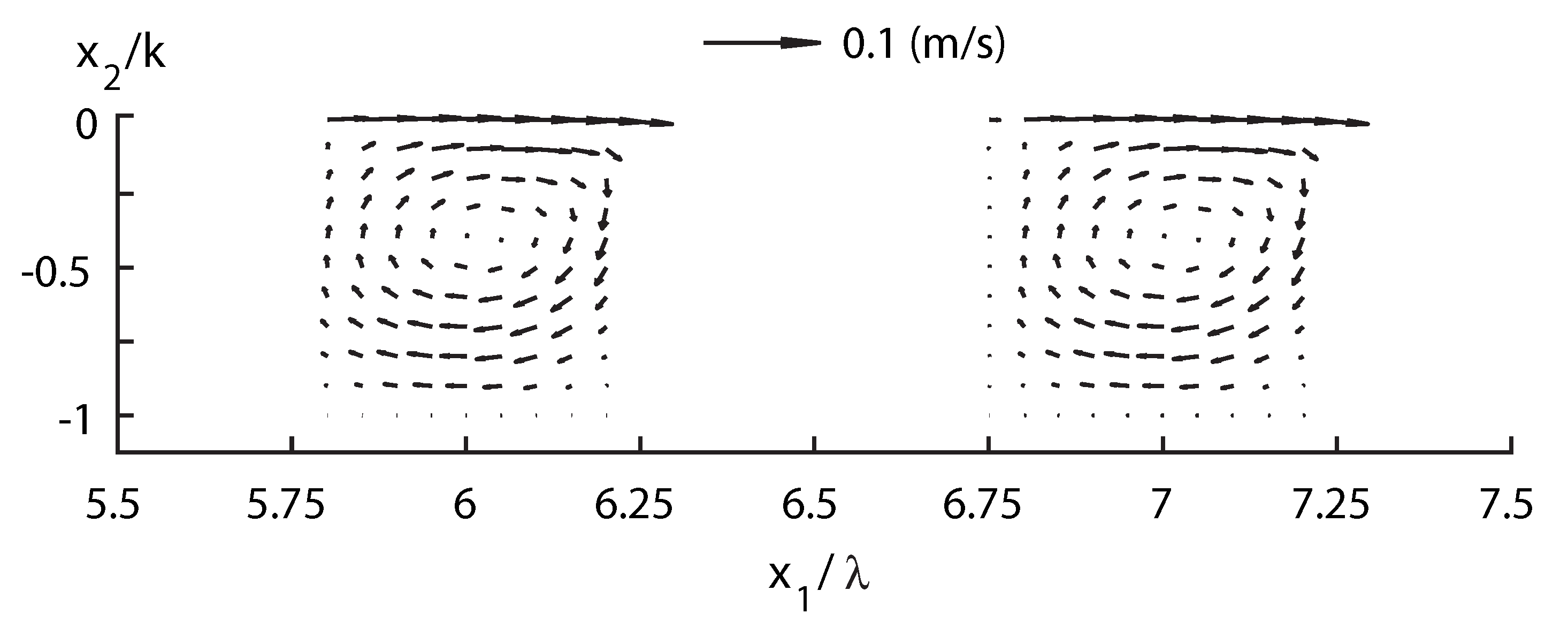



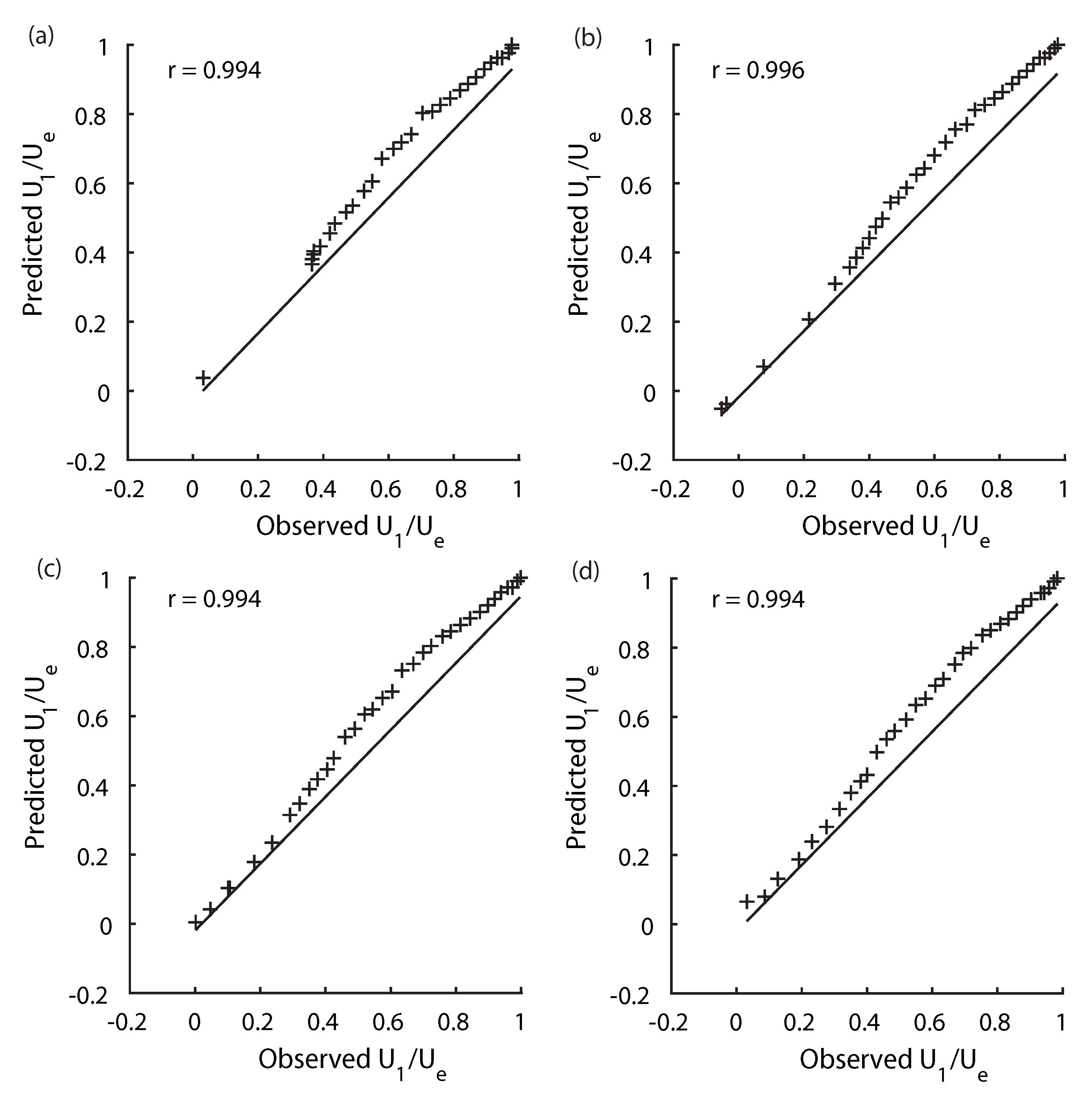

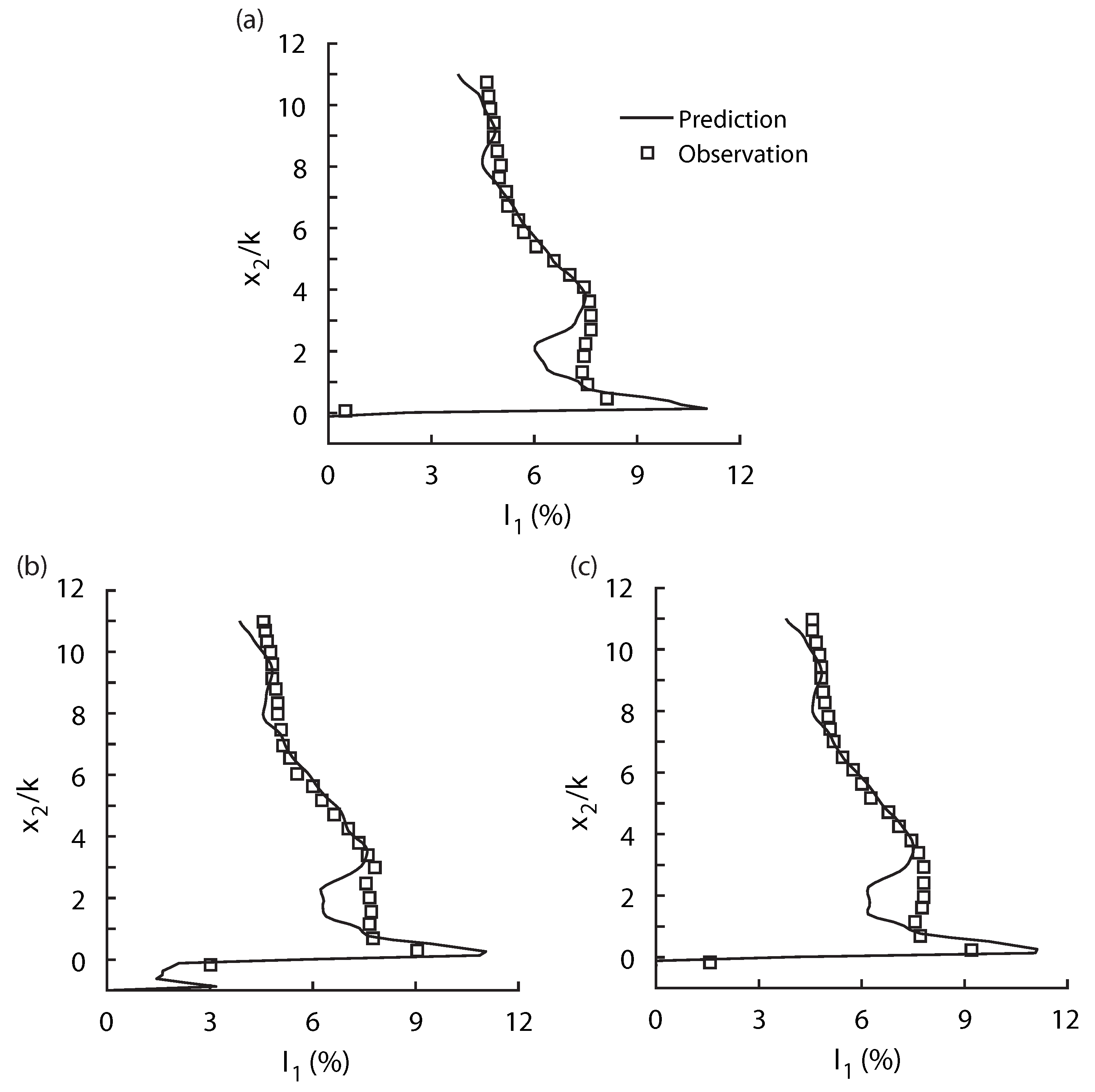
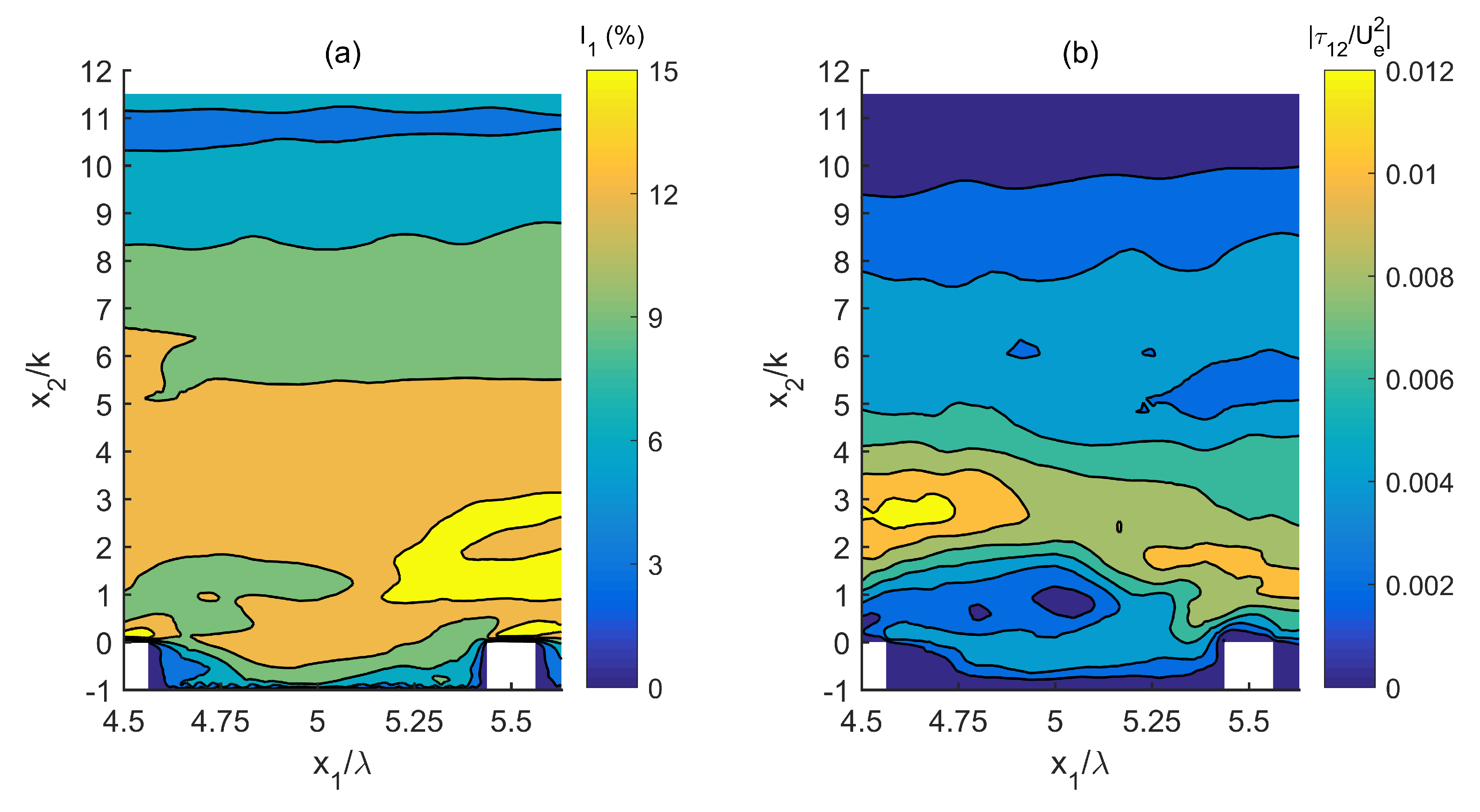
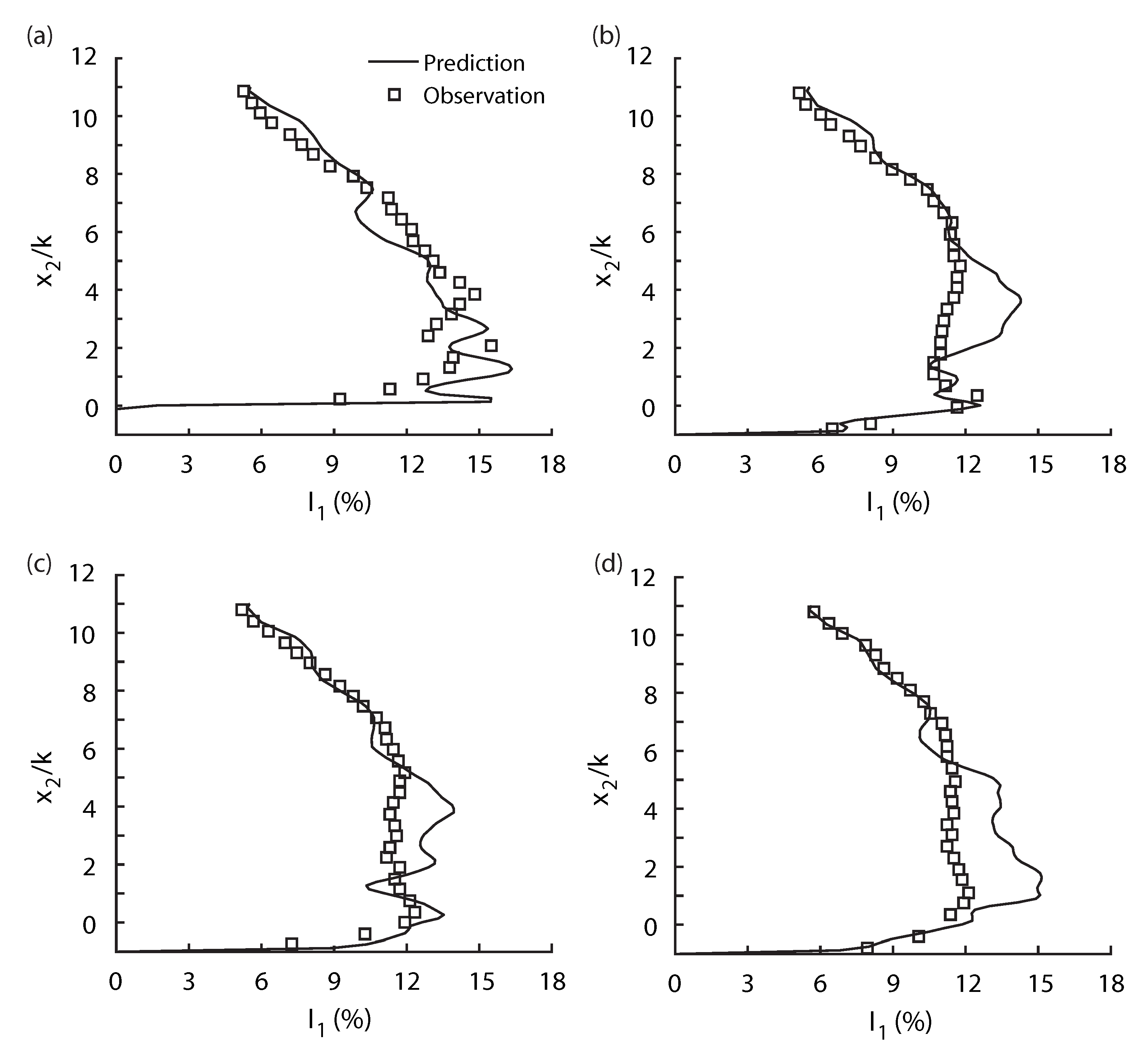

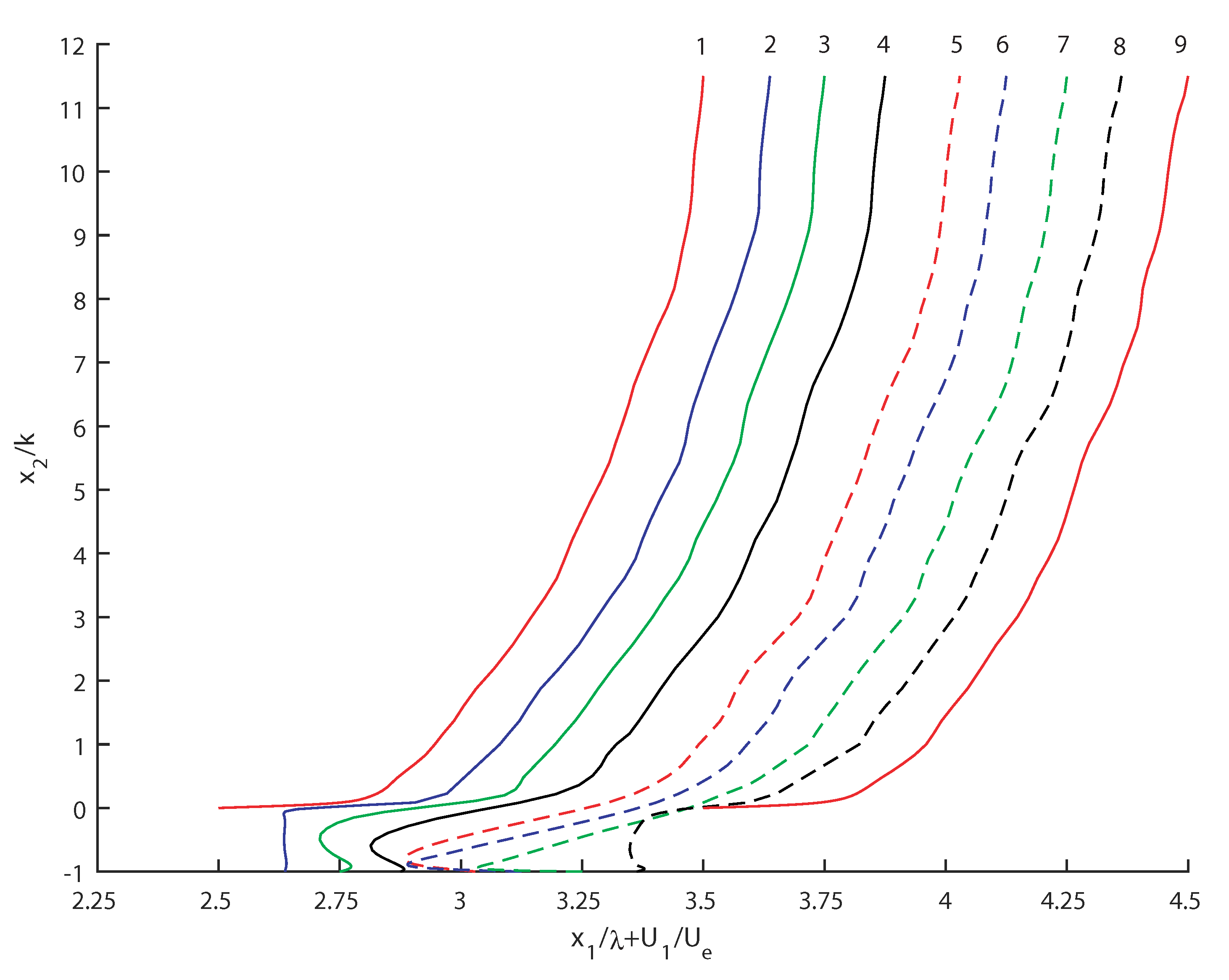


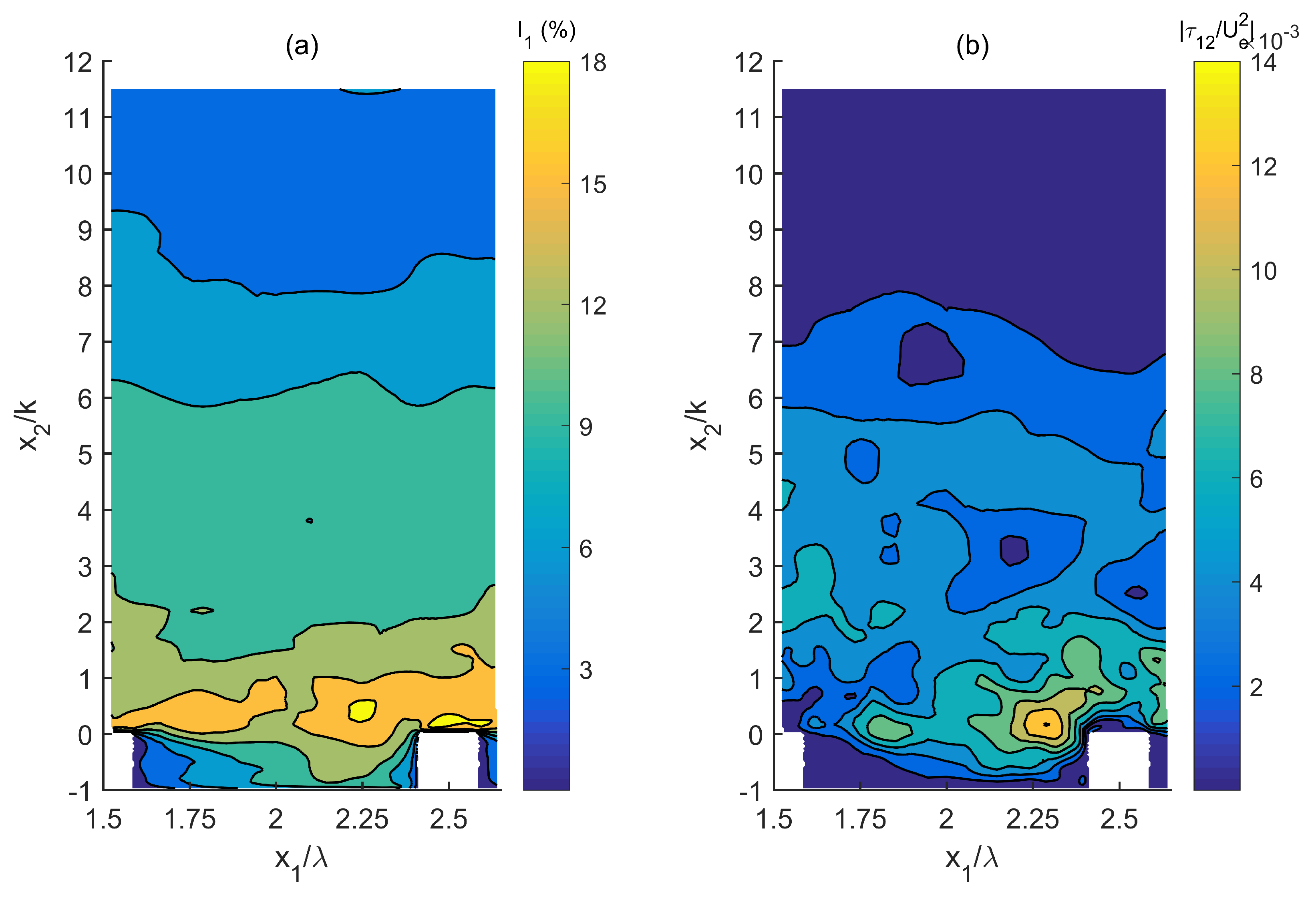

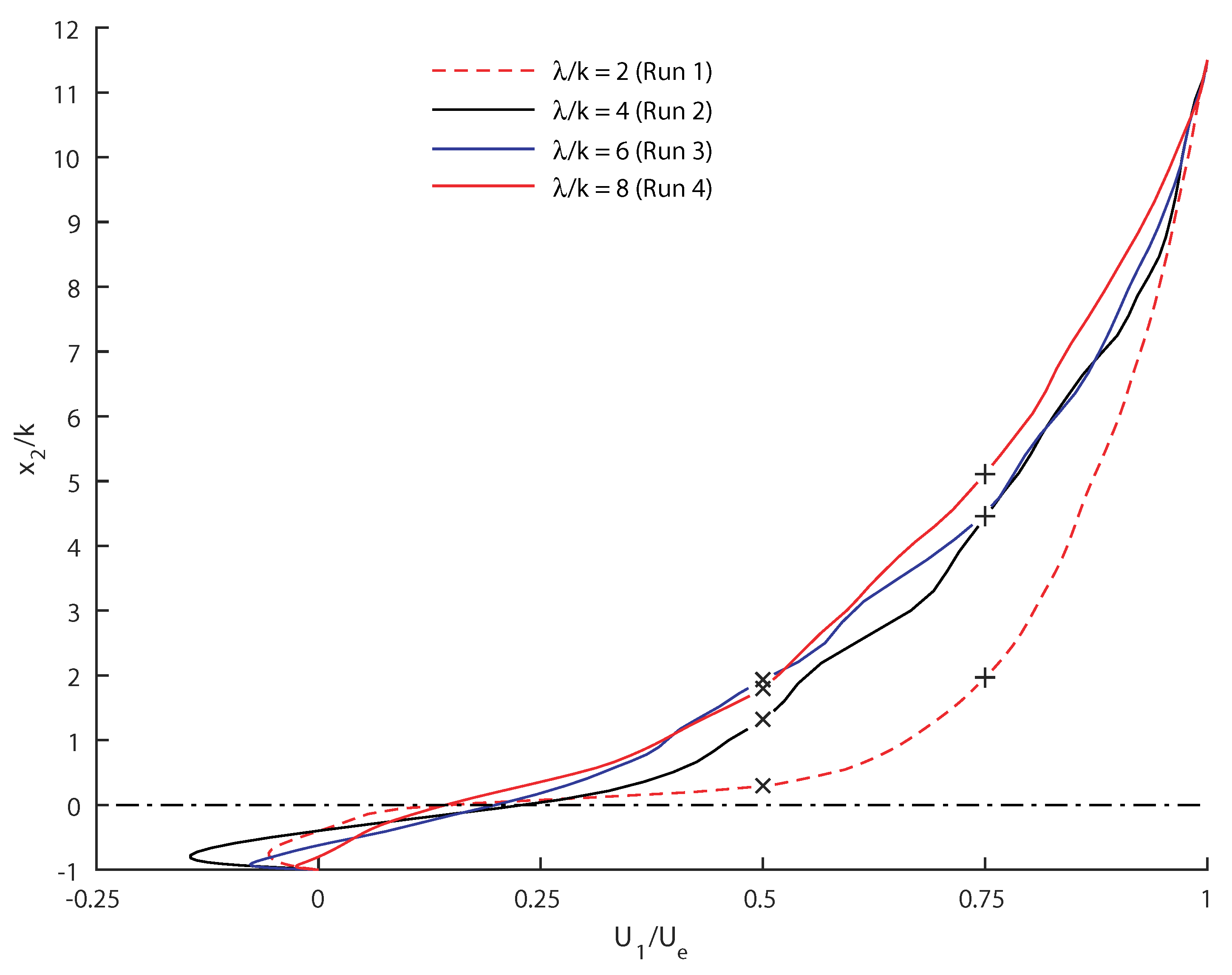
| Run | D | L | k | N | f | T | Re | Fr | |||
|---|---|---|---|---|---|---|---|---|---|---|---|
| (m) | (m) | (m) | (s) | (Hz) | (m/s) | (s) | |||||
| 1 | 0.075 | 0.156 | 0.006 | 2 | 1,117,857 | 0.001 | 20 | 0.400 | 0.39 | 27,600 | 0.49 |
| 2 | 0.075 | 0.168 | 0.006 | 4 | 769,674 | 0.0001 | 10 | 0.395 | 0.43 | 27,255 | 0.48 |
| 3 | 0.075 | 0.18 | 0.006 | 6 | 640,100 | 0.0001 | 10 | 0.386 | 0.47 | 26,634 | 0.47 |
| 4 | 0.075 | 0.48 | 0.006 | 8 | 1,689,732 | 0.001 | 10 | 0.380 | 1.26 | 26,220 | 0.46 |
| Run | Mesh Size | Growth Rate | |||
|---|---|---|---|---|---|
| Roughness-Top Surface | Cavity-Bed | Water Surface | Cavity | Outer Region | |
| 1 | (4.8–19.3, 1–9.7) | (9.7–19.3, 1–9.7) | (9.7–38.6, 48.3) | 1.2 | 1.05 |
| 2 | (4.8–19.3, 1–9.7) | (9.7–28.9, 1–9.7) | (9.7–38.6, 48.3) | 1.1 | 1.05 |
| 3 | (4.8–19.3, 1–9.7) | (9.7–38.6, 1–9.7) | (9.7–38.6, 48.3) | 1.1 | 1.05 |
| 4 | (4.8–19.3, 1–9.7) | (9.7–38.6, 1–9.7) | (9.7–38.6, 67.5) | 1.2 | 1.05 |
© 2020 by the authors. Licensee MDPI, Basel, Switzerland. This article is an open access article distributed under the terms and conditions of the Creative Commons Attribution (CC BY) license (http://creativecommons.org/licenses/by/4.0/).
Share and Cite
Zhang, Z.; Li, S.S. Large Eddy Simulation of Near-Bed Flow and Turbulence over Roughness Elements in the Shallow Open-Channel. Water 2020, 12, 2701. https://doi.org/10.3390/w12102701
Zhang Z, Li SS. Large Eddy Simulation of Near-Bed Flow and Turbulence over Roughness Elements in the Shallow Open-Channel. Water. 2020; 12(10):2701. https://doi.org/10.3390/w12102701
Chicago/Turabian StyleZhang, Zeng, and S. Samuel Li. 2020. "Large Eddy Simulation of Near-Bed Flow and Turbulence over Roughness Elements in the Shallow Open-Channel" Water 12, no. 10: 2701. https://doi.org/10.3390/w12102701
APA StyleZhang, Z., & Li, S. S. (2020). Large Eddy Simulation of Near-Bed Flow and Turbulence over Roughness Elements in the Shallow Open-Channel. Water, 12(10), 2701. https://doi.org/10.3390/w12102701






